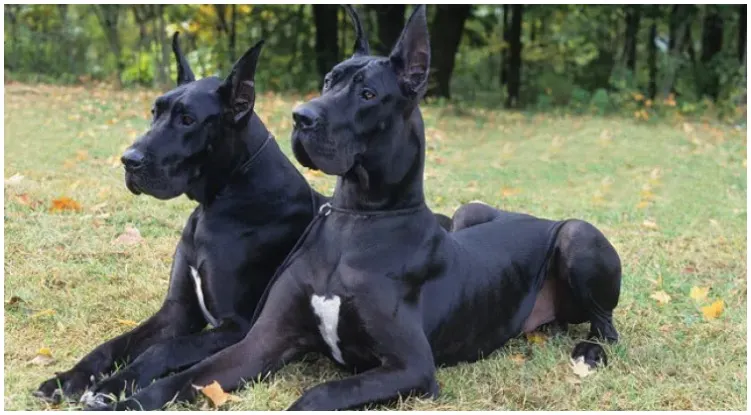Great Danes are beautiful dogs. A bit scary looking because of their size, but still beautiful. This German breed comes in many beautiful colors, but the most common is fawn. We all have probably seen a fawn Great Dane at some point in our lives. But, have you ever heard of the black Great Dane?
If not, don´t worry, they are somewhat rare. Despite being relatively rare, clack Great Danes aren’t a separate breed, they are a color variation. Now imagine the largest dog breed in the world but with a glossy black coat! This combination makes the black Great Dane look intimidating, to say the least. But, don’t worry. At their core, black Great Danes are complete sweethearts and gentle giants.
In this article, we’ll talk more about Great Danes in general. And also Great Dane colors, their health issues, characteristics, and much much more!
Read more about Great Danes and their mixes:
- Great Dane price: Giant dogs with a giant price tag?
- Great Dane Lifespan: What To Expect
- European Great Danes vs American Great Danes
- Blue Great Dane: Why they’re different
- Great Dane Lab Mix: Breed Guide
- Doberman Great Dane Mix: Gentle giant
- Great Dane Poodle Mix: The confident canine
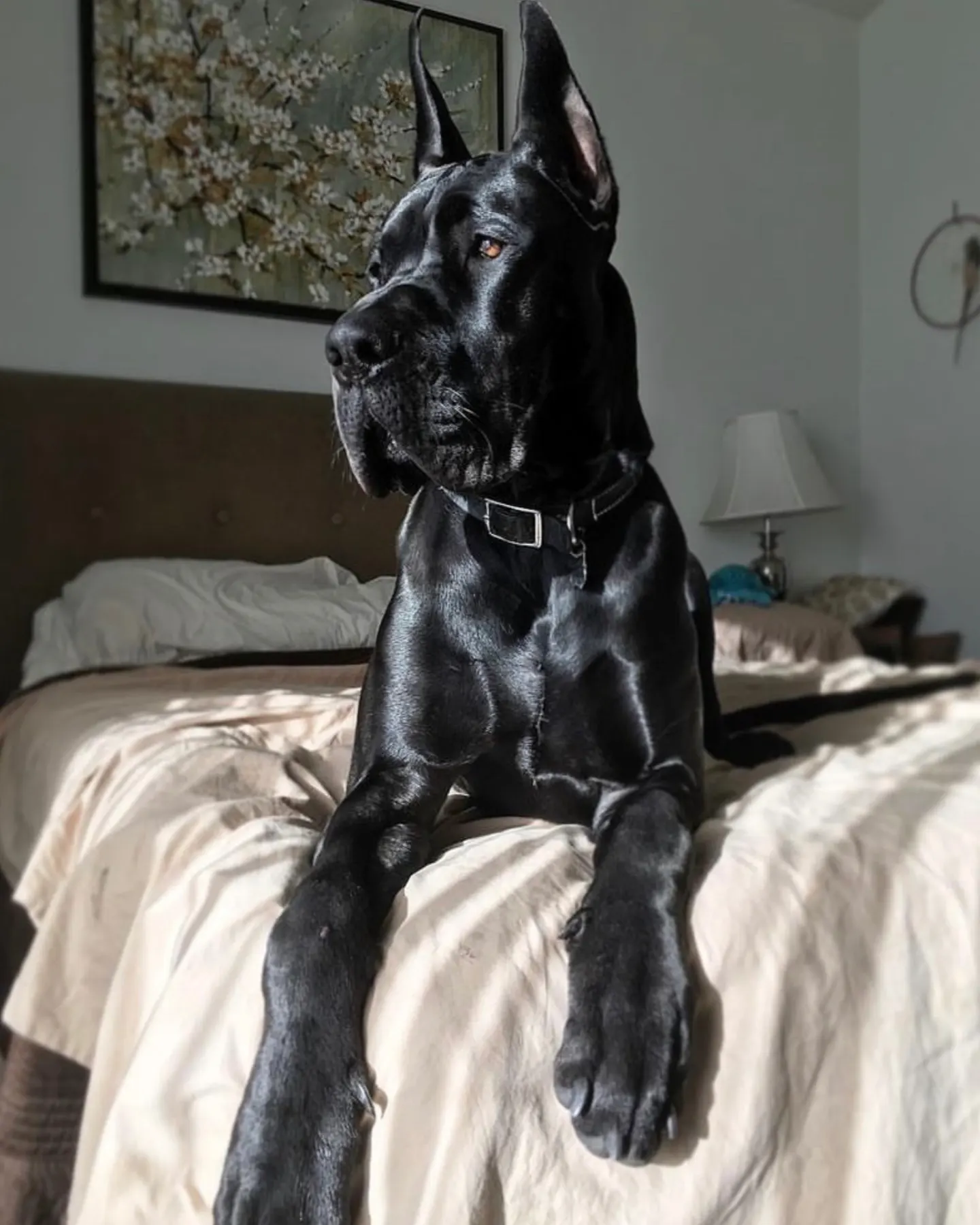
History of Great Danes
We have already mentioned that Great Danes originally come from Germany. That explains their other two names: Deutsche Dogge and German Mastiff. But, that´s not entirely true. The history of the Great Danes is a bit more complicated.
There are drawings of dogs similar to Great Danes on Egyptian artifacts that date back to 3000 BC. And also in Babylonian temples built around 2000 BC. There’s strong evidence that similar dogs came from Tibet. Besides that, in Chinese literature, there were written reports of dogs like this in 1121 B.C. Some people think that the English Mastiff’s ancestors played a role in the development of the Great Dane breed. Others think that the Irish Wolfhound or Irish Greyhound may have played a role in the process.
But, during the late 1600s, much German nobility started keeping the biggest and most gorgeous of their dogs in their residences. They named them Kammerhunde (Chamber Dogs). Their owners would dress their canines lavishly, with gilt collars lined with velvet. What a wonderful life you have.
When a French naturalist visited Denmark in the 1700s, he encountered a variant of the Boar Hound that was leaner and more like a Greyhound in look. He named this dog Grand Danois, which later became Great Danish Dog, with the larger representatives of the breed known as Danish Mastiffs. Despite the fact that Denmark did not create the breed, the name stayed. But as to public knowledge, there is no known reason why Great Danes got their name after Denmark.
German breeders developed the Great Dane
Most breed historians credit German breeders for developing the breed into the well-balanced, beautiful dog we know and love today. Breeders and judges met in Berlin in 1880 and decided that since the dogs they were producing were from the English Mastiff, they would assign it its own name—Deutsche Dogge (German Dog).
According to Wikipedia, the Englische Dogge or English Mastiff was a catch dog used after the other hunting dogs to seize the bear or boar and hold it in place until the huntsman was able to kill it. When the hunting customs changed, particularly because of the use of firearms, many of the involved dog types disappeared.
Rich German breeders continued to improve the breed during the late 1800s. They focused on the dog’s temperament since Great Danes had aggressive, vicious temperaments owing to their origins as hunting dogs for wild boar, a particularly nasty beast. These breeders attempted to make more compassionate creatures, and fortunately for us, they were successful.
We don’t know when or where the first Great Danes arrived in the United States, but the Great Dane Club of America was founded in 1889. It was the fourth breed club to be admitted to the American Kennel Club.
Appearance of the black Great Dane
Great Danes are purebred dogs so there is a standard to how this breed needs to look like. In fact, there is a standard for every purebred dog. That standard is set by a parent breed club and accepted officially by national or international bodies.
According to the AKC standard, these dogs look powerful and fierce, with their large muscular bodies, large size, and elegant balance. This is a short-haired working dog, originally used as a hunting dog. The most prominent physical characteristic of the Great Dane is, of course, its immense size. They are the American Kennel Club’s tallest canine and among the biggest overall. You can read more about their size in our article “How Big Do Black Great Danes Get And How Fast Do They Reach Maturity“.
Their large, floppy ears ask for a massage, and their drooping cheeks are yearning for a snuggle. But at the same time, there is a particular grace to their sturdy weight and height. Great Danes have a royal demeanor, and although they’re well-muscled dogs, they’re also fairly dignified with a dash of naughty wit.
But let´s go into more detail about what these dogs look like.
The ears of Great Dane are medium-sized and you can keep them completely natural and floppy, or some owners crop their ears, so they are straight. Some people believe that ear cropping helps with ear infections, but there isn´t enough evidence to prove this point.
If you would like to read more on the topic of cropped ears, you can check out the following article:
They have beautiful, almond-shaped, and dark eyes, except in harlequins and merles. Those dogs have lighter-colored eyes, usually blue or some other color. The nose of a Great Dane is black. But other colored Great Danes can have noses that are some other color. The overall muzzle shape is broad and deep. Their tails are long and never docked.
Breed colors
Great Danes come in many different colors, including black (which we’re talking about today), black and white, blue, brindle (which look like very subtle tiger stripes), fawn Great Dane, harlequin (which is a white base with black patches), mantle (which black with white markings or patches), merle (merle markings are mottled patches of color) and completely white.
One of the most interesting-looking Great Danes is the mantle, Great Dane. Here´s what the mantle pattern looks like: solid merle blanket extending over the body, merle skull with a white muzzle, white blaze (optional), whole or just partially white neck, a white chest, white on whole or part of the forelegs, and hind legs and lastly a white-tipped merle tail.
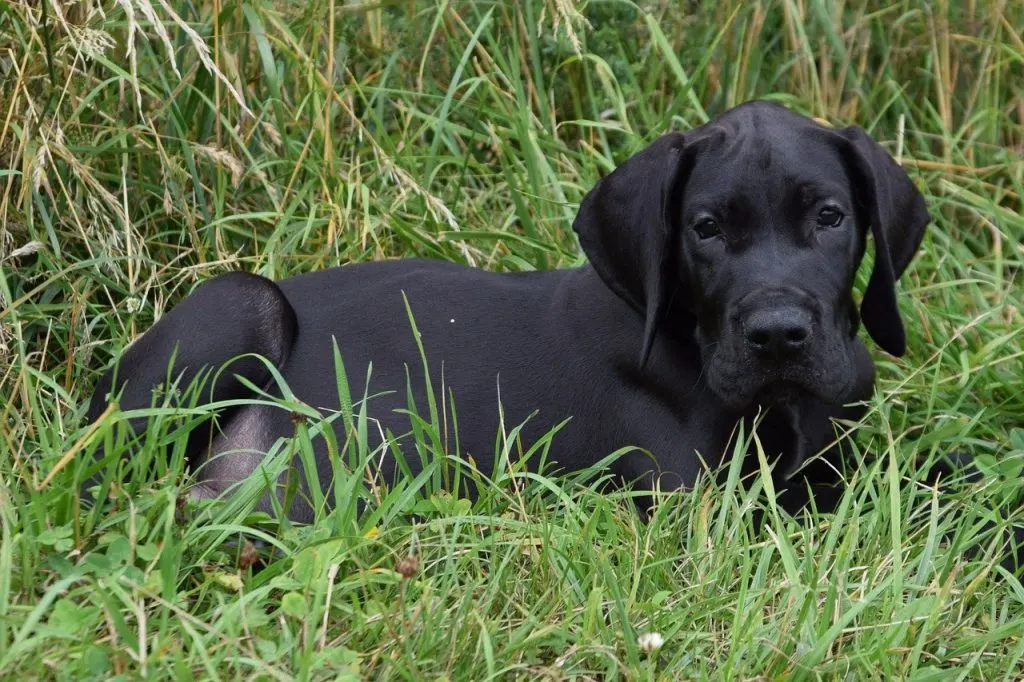
Today, many people own Great Danes as family dogs, because they truly are gentle giants. But, just like with every other large hunting dog, you will have to take some precautions. You might be wondering why we´re talking about Great Danes in general if this article is supposed to be about the black Great Dane. Well, a dog of any color requires the same level of responsibility, generally speaking, all Great Danes have the same body build, every Great Dane is a giant dog with a big and sweet personality.
The difference is just that some have the merle gene, some have the blue gene, and so on. But one thing is for sure, all of them deserve proper care and an owner that knows their breed well. We talked more about their different hues in our article “What is the rarest Great Dane color?“.
Personality
Now we’ve covered the appearance and variety of colors of Great Danes, but now we need to look at all of their traits, their personality. We have a full article about their compatibility as a family dog called “Are Great Danes good family dogs?“, so we will keep things brief here.
If you own a black Great Dane, then you probably already know that they are big babies and velcro dogs. They are loving and affectionate, and they oftentimes do not realize their own size. Great Danes prefer to be close to their owner and will try to climb into their owner’s lap while sitting on the couch.
Great Danes are friendly canines that like pleasing their owners. They are content to spend time with their families, whether it is strolling along a walking route or snuggling up on the sofa for a movie night. Keep a towel available in case their extra-long tongues kiss your face! They are often referred to as the largest lap dog and if you want to own one of these dogs, definitely buy a big couch. Sometimes they can get aggressive, but only when scared.
It’s incredibly important to train and socialize Great Danes as soon as possible. The good news is that these puppies are very clever. They are quick learners that desire to please their owners. The best way to teach them is to slow down and give them a lot of positive reinforcement.
Training is of utmost importance because of the height and power of these dogs, you should teach them proper leash etiquette and give them the confidence to go out in public. You also don’t want your dog to be scared or frightened. When it comes to strangers, black Great Danes can feel pretty uncomfortable around them. If a Great Dane or black Great Dane begins to feel fearful, they can start to act aggressively. Especially if you haven´t trained them well or socialized them from puppyhood.
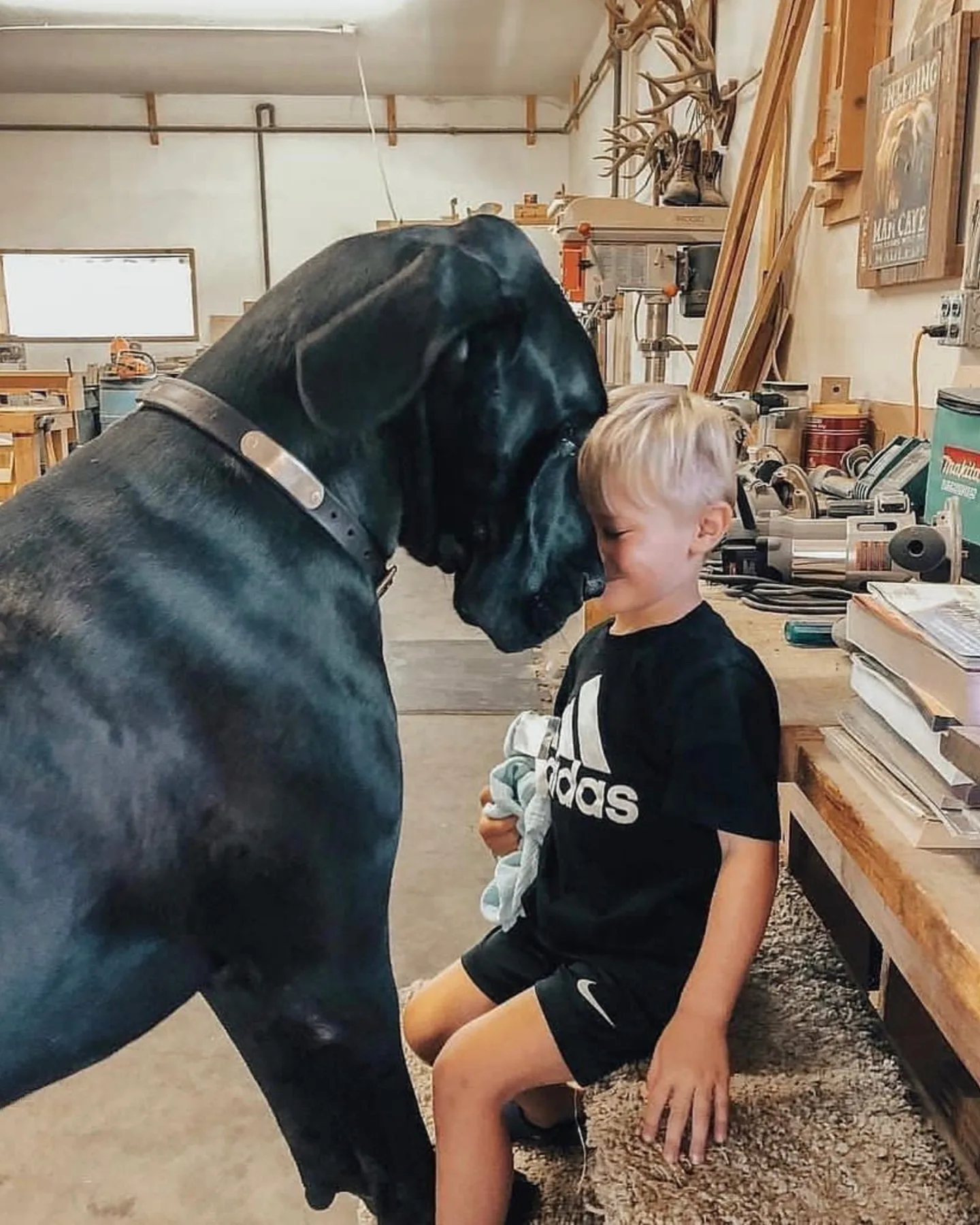
Source: Instagram (@greatdane.familydog)
What makes the Black Great Dane black?
Black Danes are the Apollo of dogs. Compare black Danes to any other breed and you´ll see why. But, how does a black Great Dane become black? Well, most commonly two Great Danes in the color black mating will lead to them producing black Great Dane puppies.
However, two black Great Danes can also produce a blue Great Dane. It´s also important to mention that most black Great Danes aren’t even full black at all. It´s hard to find a pure black dog of this breed. Instead, they are born with mild to moderate white fur on the body, typically on the chest and toes. We can find this color combo usually when a Harlequin/Harlequin or a Harlequin and Black breeding occurs.
AKC won’t consider a Great Dane with any other color markings, including white, to be qualified as a true black Great Dane. Another unacceptable issue with trying to obtain a black Great Dane is by breeding a Brindle and a Black Fawn color combination, as well as a Fawn and Black together. These combinations often produce black offspring, however, it is not acceptable with the AKC.
Popularity
If you’re wondering why black Danes are so popular — it’s pretty simple. Everything looks better in black, even the Great Dane. The black color of their coat makes it shine and glisten a bit more, showing off every muscle on their body. The dog appears exceptionally muscular, which can they make a better candidate for a show puppy.
Most people who own Great Danes, still choose to keep with the traditional look of the breed and have the ears cropped. Originally we would crop their ears in an effort to help prevent injuries to their ears when they were hunting. Basically, when you crop a dog´s ears it helps prevent the dog’s ears from getting snagged. Even though some people let the ears grow and fall naturally into their place, many don’t consider this the traditional look of the dog.
Where to buy a black Great Dane?
If you want to buy a black Great Dane we can recommend looking into Velocity Great Danes, we´ll put a direct link to them HERE. They are completely reliable and breed their dogs in the best way possible. Here is what they have to say about themselves:
Our Danes are family first. Their lifetime happiness and well-being are our priorities. Our Danes are not kennel dogs but live in our home with us. We will only place our puppies in homes with families committed to doing the same. No exceptions. We are proud of not only the dogs we have bred but of our families that have committed to giving a Velocity Great Dane an amazing life as their loved family member.
What is great about them is that they test their Great Danes for the most common health issues:
We believe in updated health testing as our Danes age to monitor any changes in Eyes, Heart, and Thyroid. This will allow us to keep a database on any issues that might develop during the aging process and provide early treatment if needed so our Danes remain happy and healthy.
If you want to connect with other people who love black Danes or just Great Danes in general, or you want to find other reliable breeders you can look into the National Breed Club of Great Danes.
Health issues
With the Great Dane, no matter if it´s a black Great Dane or any other coat color, it´s important to know that these dogs have many health issues, primarily because of their size. Their lifespan is also pretty short, and most of them will only live for 8-10 years.
You should know that large dog breeds often have more health issues than smaller dogs. And besides that, their life expectancy is much lower than that of small breeds.
The life expectancy of large breeds like German Shepherds, Golden Retrievers, Labrador Retrievers, Rottweilers, and Doberman Pinschers, as well as giant breeds such as Great Danes, St. Bernards, and Mastiffs is between 8 to 12 years.
In comparison, the life expectancy of small dogs like Yorkshire Terriers, Chihuahuas, Shih Tzus, Welsh Corgis is between 10 and 15 years. Some owners state that their beloved pooch lived up to 18 years. As you can see the difference in life expectancy cannot be ignored.
The reason why the life expectancy of large dogs is so much shorter is that their aging process is much faster. It means that they age very quickly. Because of their size, the aging process puts more strain on the dog´s physiological processes, simply put they tend to wear out more quickly.
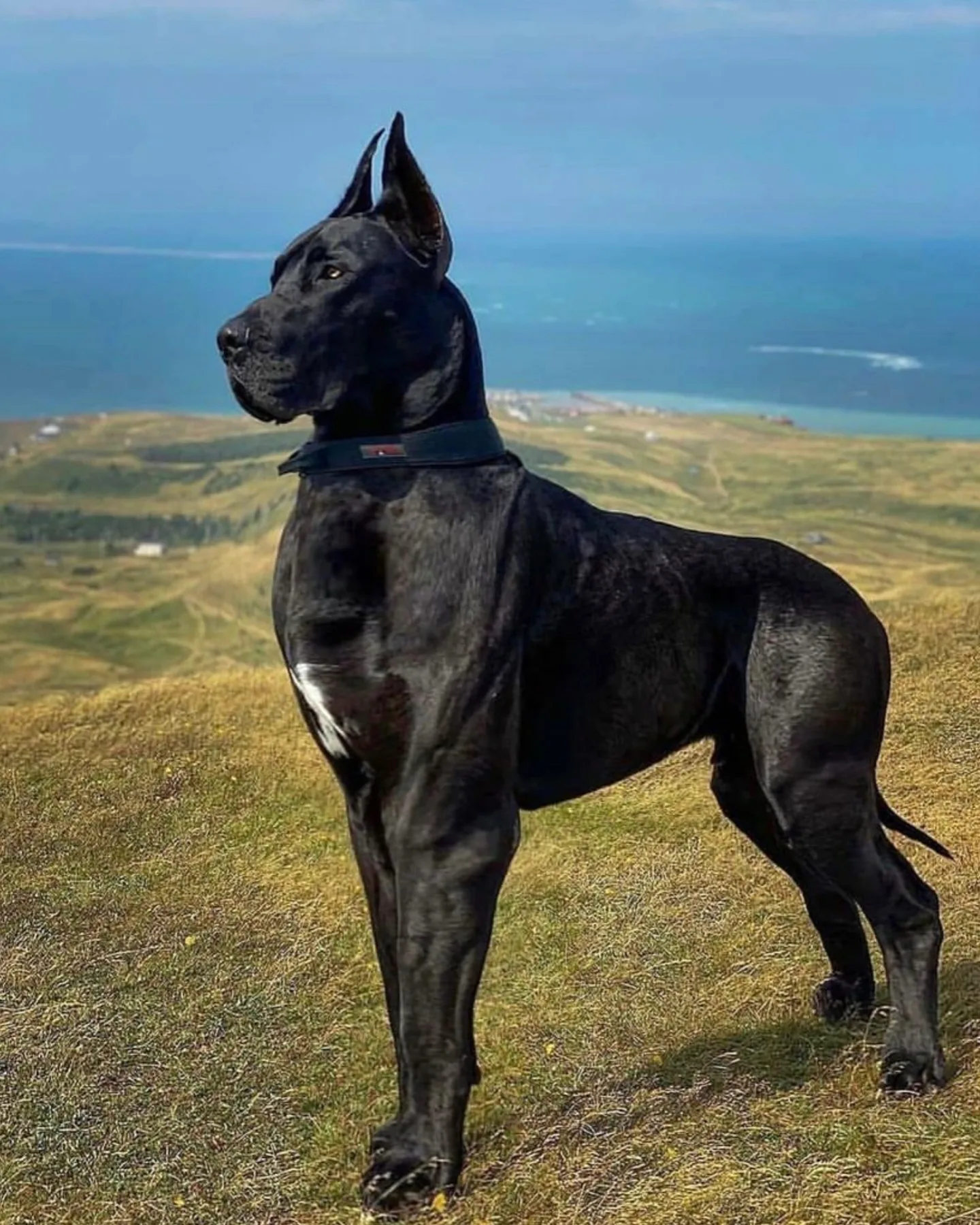
Source: Instagram (@greatdanesentuidis)
Black Great Dane health
When it comes to the Great Dane specifically, their life expectancy is between 8 and 10 years. But in those 8 to 10 years, there are many health issues you need to keep in mind and keep track of. Your dog might be completely healthy for the rest of its life, but as a responsible dog owner, you should know all the most common health issues of the breed you have and their symptoms. That way you can spot the symptoms early on and maybe save your dog´s life.
Now, when it comes to the most common health issues, the number one is hip dysplasia. Hip dysplasia is a disorder that arises in dogs throughout their growing period. It causes hip joint laxity, which causes dysfunction and discomfort.
The cartilage and bone of the hip begin to wear away as the dog develops. This causes arthritis, muscular atrophy, and decreased movement over time. It mostly affects large-breed dogs, and research indicates that it is inherited.
Other health issues include bloat, and also heart conditions that can largely shorter their life expectancy, so heart testing is a good idea. Another less serious health condition is Wobbler disease. Also, look out for hereditary eye diseases and other eye issues, This condition develops due to the fast-growing pace of a Great Dane. It causes the vertebrae to push up against the spinal column, which then makes the legs weak.

